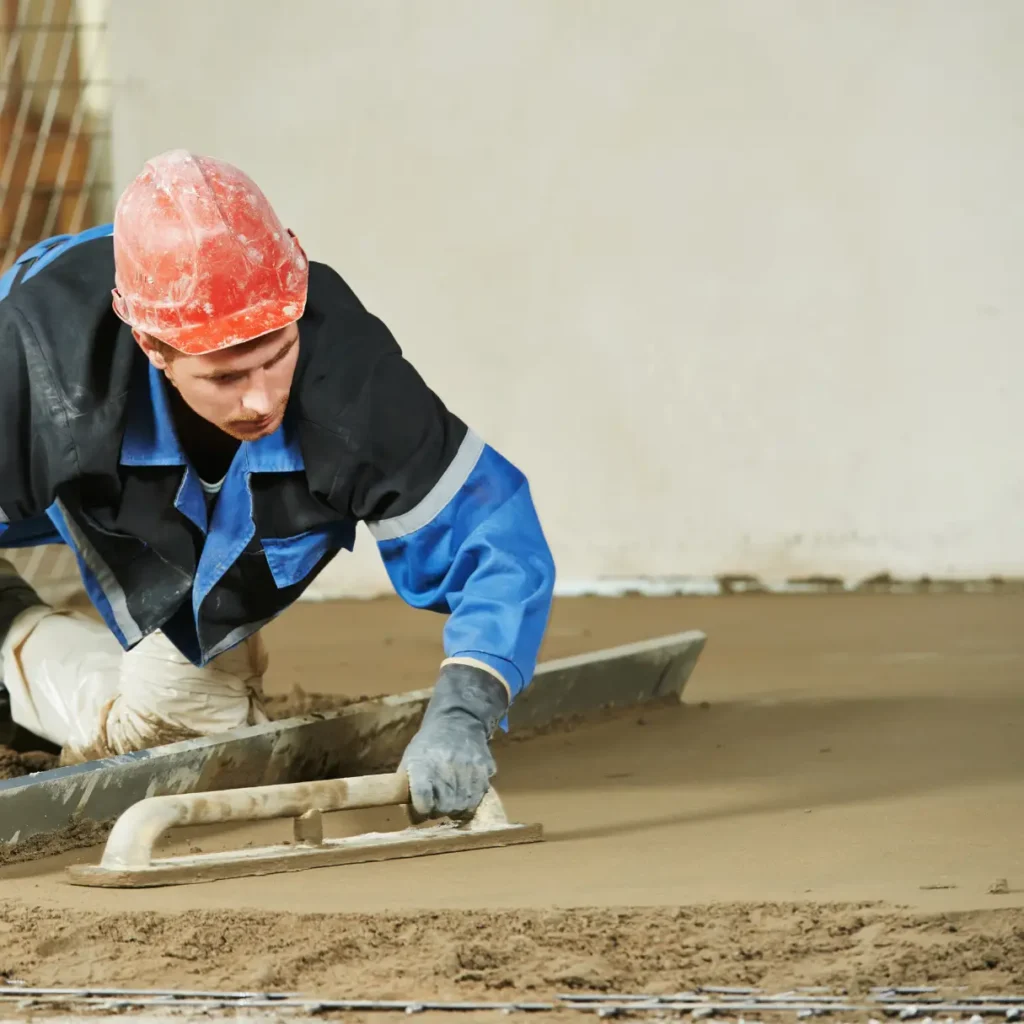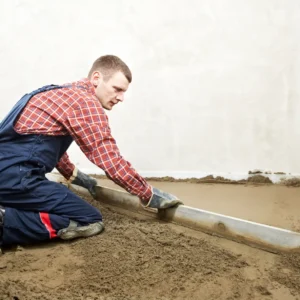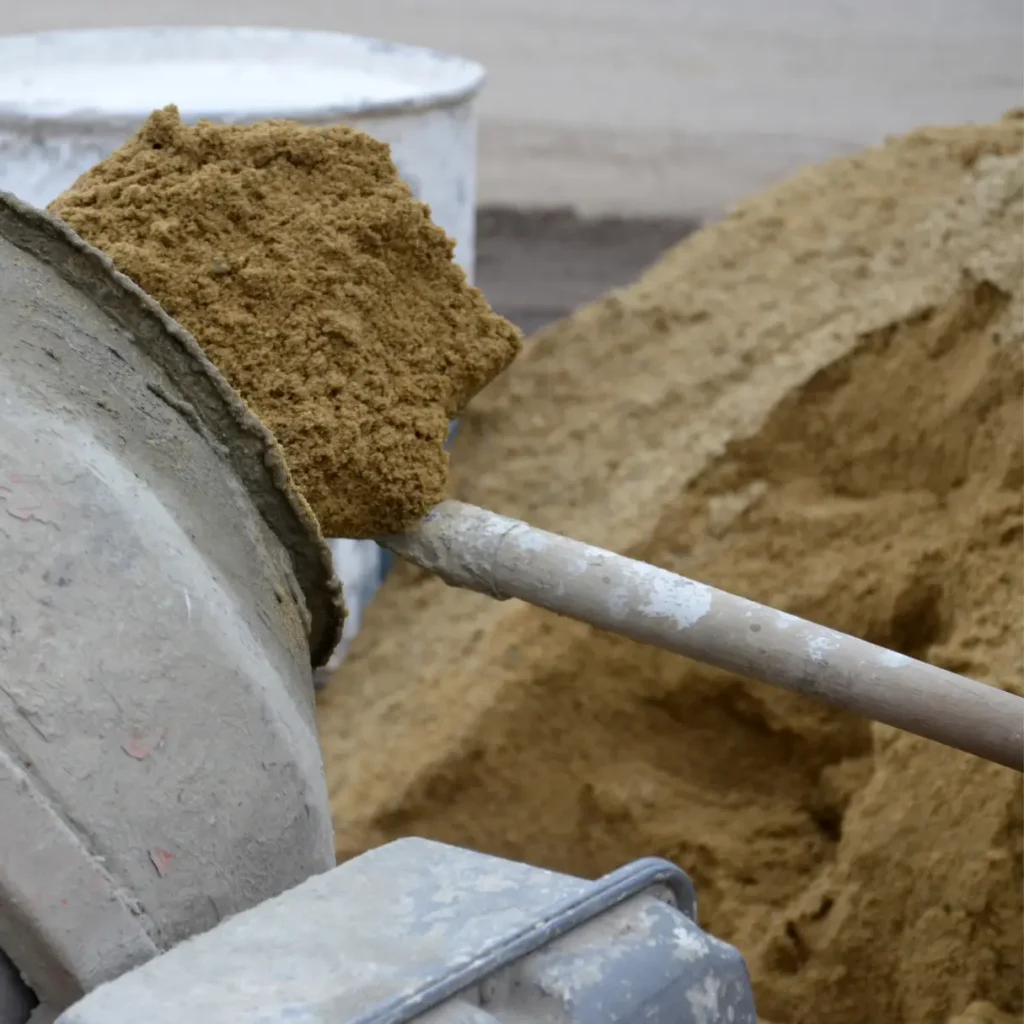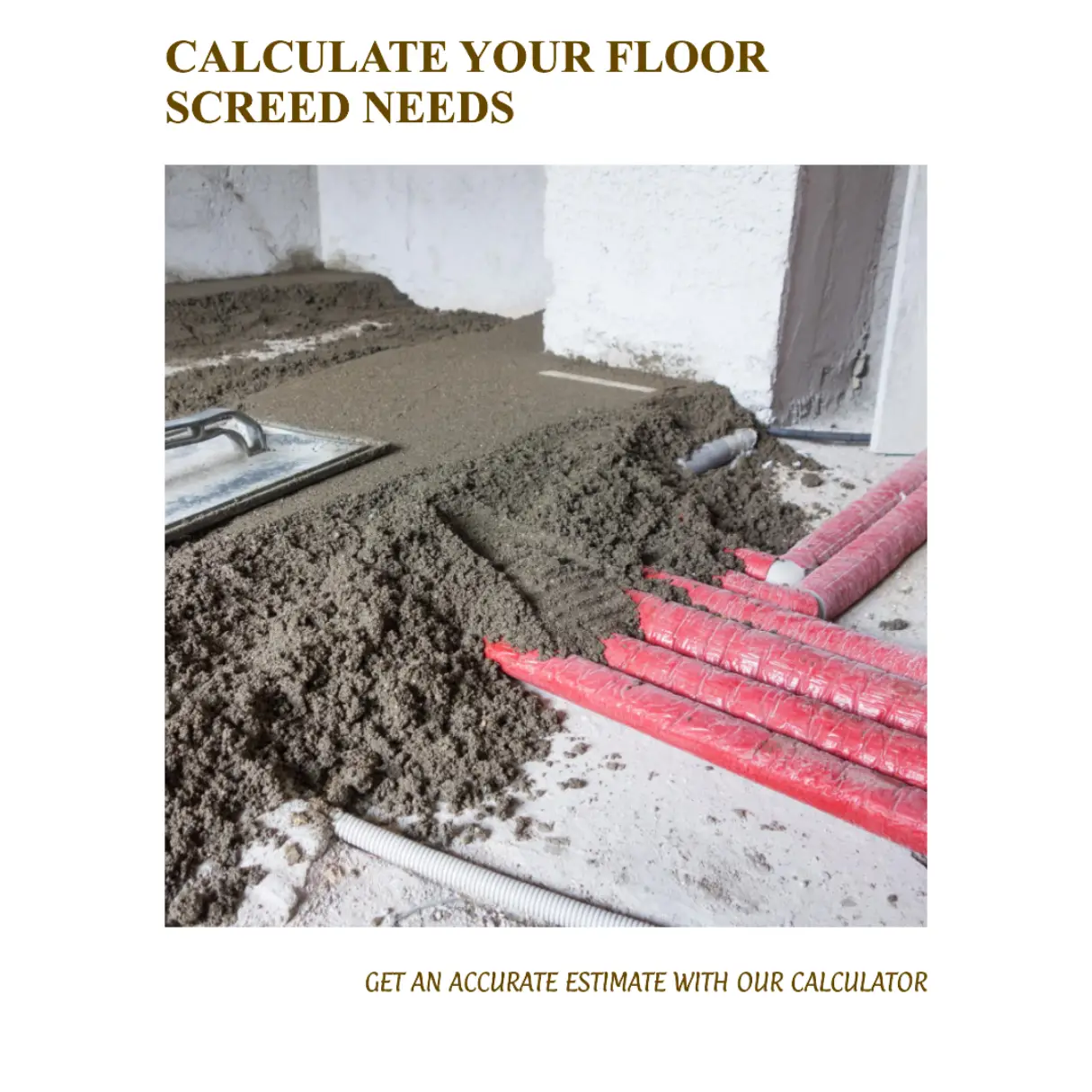This Floor Screed Mix Calculator is designed to provide you with accurate calculations, ensuring that you have just the right amounts of materials for a flawless sand and cement screed mix.
Say goodbye to the uncertainty of estimating cement and sand quantities for your flooring or leveling ventures.
Take the guesswork out of the equation and embark on your flooring journey with our floor screed material calculator!
Sand and Cement Floor Screed Calculator
Screed Mix Calculator
Cement: 0 kg, Sand: 0 kg
How to Use the Floor Screed Mix Calculator
- Enter the total area (in square meters) that you want to cover with the screed mix.
- Enter the desired depth of the screed mix (in millimeters).
- Select the screed mix ratio (cement: sand) from the dropdown menu. Our calculator supports three mix ratios: 1:3, 1:4, and 1:5.
- Click the “Calculate Materials” button to get the estimated amount of cement and sand needed for your project, displayed in kilograms.
Why Use a Floor Screed Mix Calculator?
Using a screed mix calculator helps you save time and money by providing an accurate estimate of the materials needed for your flooring or leveling project.
This enables you to plan ahead, order the right amount of materials, and avoid costly mistakes.
Additionally, using the right screed mix ratio is crucial for achieving the desired strength, durability, and leveling properties in your project.

What is Floor Screeding?
Floor screeding is a construction technique used to create a smooth, level surface on a concrete or masonry subfloor.
It involves applying a layer of material, known as screed, over the base floor to achieve a uniform and flat surface that can serve as a foundation for various types of floor finishes such as tiles, wood flooring, carpets, or vinyl.

The primary purposes of floor screeding are:
- Leveling: Screeding helps to correct any irregularities or imperfections in the base floor, ensuring that the final floor finish is even and aesthetically pleasing.
- Smoothness: By creating a smooth and flat surface, screeding eliminates any bumps, dents, or other irregularities that could affect the installation of flooring materials.
- Subfloor Preparation: Screeding provides a solid and stable surface for applying various types of floor coverings. It helps to create an optimal base for the installation of tiles, carpets, hardwood, laminate, and other flooring materials.
- Thermal and Acoustic Properties: Depending on the type of screed used, it can also contribute to the thermal and acoustic insulation of the floor.
There are different types of screeds, each with its own characteristics and benefits
Sand and Cement Screed
This is a mixture of cement, sand, and water. It’s widely used and provides good strength and durability. However, it may require longer drying times.

Self-Leveling Screed
These screeds are pre-mixed and are designed to flow and settle into a level surface on their own. They are great for large areas and can provide a smoother finish.
Anhydrite Screed
This type of screed uses anhydrite (calcium sulfate) as a binder instead of cement. It has faster drying times but may not be suitable for areas with high moisture levels.
Polymer-Modified Screed
Polymer additives are mixed with the screed mix to improve properties such as flexibility, adhesion, and durability.
Fiber Reinforced Screed
Fibers (usually synthetic) are added to the screed mix to enhance its strength and prevent cracking.
The application process typically involves preparing the subfloor, installing edge restraints to contain the screed, mixing the screed material, pouring it onto the surface, and then leveling and smoothing it using tools like trowels and straightedges.
It’s important to follow proper curing and drying procedures to ensure the screed gains sufficient strength before further construction activities or floor covering installations.
Tips for Mixing and Using Floor Screed Mix
- Always follow the manufacturer’s guidelines for mixing screed mix. This includes the correct mix ratio, mixing technique, and water content.
- Use clean, potable water when mixing screed mix to ensure a consistent and strong mix.
- Mix the screed mix in small batches to ensure it remains workable and does not harden before it can be used.
- Apply screed mix evenly and consistently to ensure proper leveling and bonding with the substrate.
- Allow the screed mix to cure properly, according to the manufacturer’s recommendations, to achieve the desired strength and durability.
FAQs
What is screed mix and what are its common applications?
Screed mix is a construction material typically composed of cement, sand, and water, used to create a smooth, level surface for flooring installations or to provide a suitable substrate for various types of floor finishes.
Common applications include leveling uneven floors, creating a flat surface for laying tiles, providing a base for underfloor heating systems, and forming a smooth, durable finish for industrial or commercial floors.
What is the recommended depth for floor screed?
The recommended depth of floor screed depends on the specific application and the type of screed mix used. Generally, for traditional sand and cement screeds, a minimum depth of 25mm is advised for bonded screeds, 50mm for unbonded screeds, and 65-75mm for floating screeds.
For more specialized screed mixes, such as anhydrite or self-leveling screeds, the manufacturer’s guidelines should be followed for optimal performance and durability.
How Long Does Floor Screed Take to Dry?
The drying time for floor screed can vary based on several factors, including the type of screed used, environmental conditions, and the thickness of the application.
To determine if the screed is adequately dry for the next steps of your project, it’s recommended to perform moisture tests such as the plastic sheet test or using a moisture meter.
It’s essential to follow the manufacturer’s guidelines for the specific screed product you’re using and to take into account the conditions in your location to ensure the screed dries properly before proceeding with further construction or floor covering installations.
How long should screed mix be allowed to cure before applying floor finishes?
The curing time for screed mix depends on the type of mix used, the thickness of the screed layer, and the environmental conditions at the site.
For traditional sand and cement screeds, a general rule of thumb is to allow one day of curing time for each millimeter of screed thickness up to 50mm, and an additional day for each additional millimeter beyond 50mm.
For specialized screed mixes, consult the manufacturer’s guidelines for curing times and conditions to ensure optimal performance.
Can I use additives in my floor screed mix to enhance performance?
Yes, various additives can be used in screed mixes to improve their performance characteristics. Some common additives include plasticizers to increase workability, retarders to slow down the setting time, accelerators to speed up the setting time, and fibers to improve the strength and crack resistance of the screed.
Always follow the manufacturer’s guidelines for the correct dosage and mixing procedure when using additives in your screed mix.
How do I know if my screed mix is properly mixed and applied?
To ensure your screed mix is properly mixed and applied, follow these tips:
- Adhere to the recommended mix ratio (cement: sand) and water content for the specific screed mix you are using.
- Mix the screed mix thoroughly and consistently to achieve a uniform, lump-free consistency.
- Apply the screed mix in a consistent manner, using a straight edge or screed rail to achieve an even, level surface.
- Monitor the curing process and protect the screed from extreme temperatures or rapid drying conditions to prevent cracking and ensure optimal strength and durability.
- Consult the manufacturer’s guidelines and recommendations for the specific screed mix used, as these may vary depending on the product.
Conclusion
By providing precise calculations based on the area, depth, and mix ratio, the calculator enables you to plan and budget your project effectively.
Understanding the different types of screed mix, their applications, and the importance of proper mixing and curing are crucial for achieving a high-quality, durable, and level surface.
This tool that helps you accurately estimate the amount of cement and sand needed for your flooring or leveling project.
Effortlessly estimate the amount of cement and sand needed for your screed mix project using our user-friendly Floor Screed Mix Calculator
Always follow the manufacturer’s guidelines and consult with experienced professionals when working with screed mix to ensure your project meets the required standards and delivers the desired results.
Author Profile

- I have many qualifications and certificates in construction, such as City & Guilds, CPCS and CITB. These are the highest standards of training and competence in the industry. Whether you need help with plumbing, carpentry, bricklaying or any other trade, I’m here to help you succeed.
Latest entries
- March 6, 2024CalculatorsWall Tile Calculator: How Many Wall Tiles Do You Need
- February 29, 2024Roof Truss Cost Calculator
- December 31, 2023Wage Take Home Calculator
- December 30, 2023Day Rate Calculator

